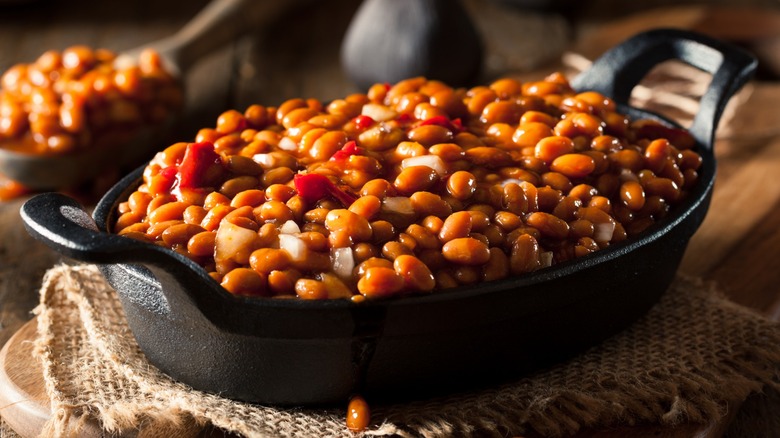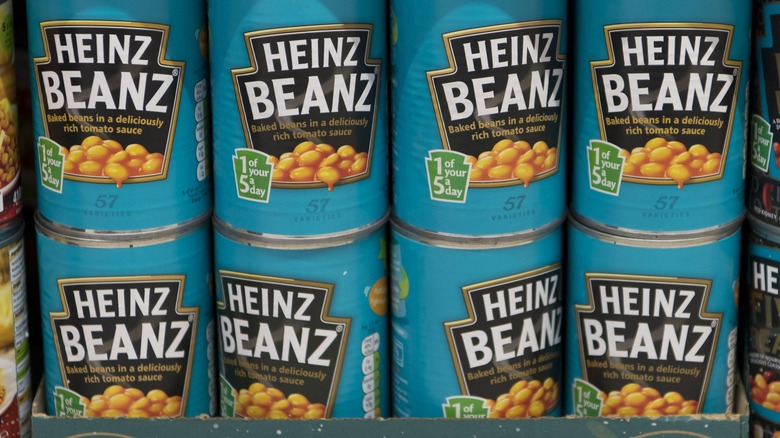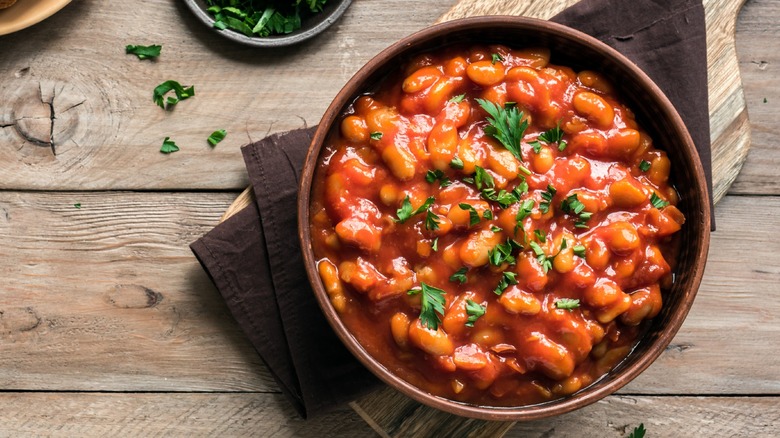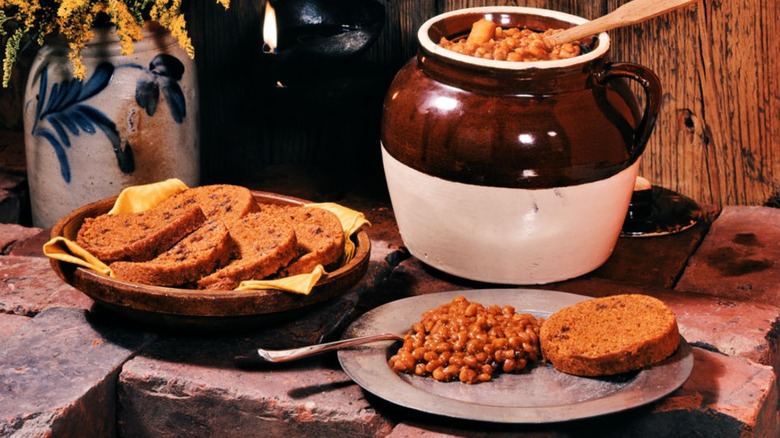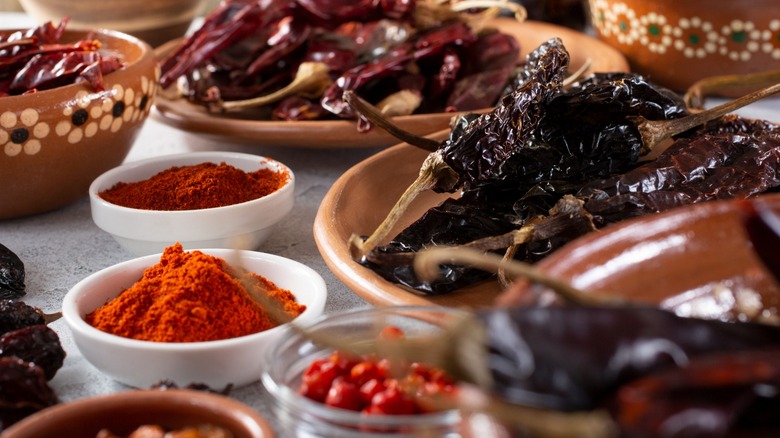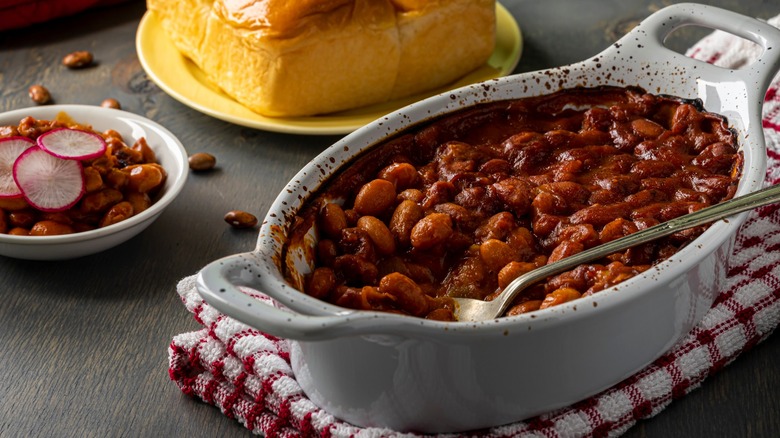Chili Beans Vs. Baked Beans: What's The Difference?
Beans are one of the most humble foods in the world, and that also means they are one of the most diverse. First grown and domesticated in the Americas, beans spread around the world after contact with Europe, and there are now over 40,000 varieties worldwide. As an affordable, filling, and healthy ingredient packed with protein, they have become a staple food in almost every cuisine, from the Middle Eastern seasoned beans ful medames to the Indian curries.
And, of course, they remain eternally popular in their original home, where bean dishes are still ubiquitous throughout Latin America and bowls of barbecue beans and bean soup are regularly enjoyed across the United States. That means that there are a lot of different bean recipes to learn, including two that are commonly served in different parts of the Americas: chili beans and baked beans.
Both chili beans and baked beans are relatively simple dishes consisting of beans in sauce, with only a few ingredients used to impart them with deep flavor. They are both also popular as a pre-cooked, canned pantry option, although baked beans are probably more familiar to most shoppers. Hidden behind those big similarities, however, are some pretty big differences. And it's not just about comparing the Southwestern spice of chili beans to the sweeter flavor of Northeastern baked beans, but examining how they are prepared, and the precise origins of those specific flavors.
What are baked beans?
Baked beans actually come in a lot of forms, but the specific dish we usually think of refers to American-style "Boston" baked beans, which are cooked in a dark, sticky sauce. Modern variations can include a lot of different spices, sauces, and condiments like ketchup, but the classic dish is made with navy beans cooked with molasses, black pepper, and salt pork. Baked beans are traditionally made by mixing all the ingredients together in a heat-proof dish and setting the oven for a long, slow cook.
The end result is a bowl of creamy, tender beans with a thick, syrupy coating. The combination of molasses and salt pork gives the dish a smoky, lightly sweet flavor, although some versions lean more sweet with the addition of things like brown sugar. Baked beans were some of the first canned products, dating back to the mid-19th century.
Although several companies claim to have originated them — and plenty of brands make canned baked beans today — they are highly associated with Heinz. The manufacturer is credited with mass producing baked beans, and also introducing them to the British market from America, where they became wildly popular and even found their way into the full English breakfast. Back home in the United States, baked beans are commonly eaten as a side with a variety of meals like barbecue, hot dogs, and cornbread.
What are chili beans?
Chili beans are less clearly defined than baked beans, but their name is a pretty clear indication of how they are made. Chili beans are just beans coated in a meaty chili sauce, reminiscent of the stew that's also called chili. Unlike the original dish, however, chili beans are mostly just beans with a smaller amount of sauce acting as gravy and flavoring. They are very much a side, not a soup. They are usually made with pinto beans, although they can also be made with black beans, kidney beans, or any other Southwestern option.
The flavor of chili beans is drawn from chili dishes like chili con carne. Just like there is no one way people can agree on when making chili, there are a lot of options for flavoring chili beans, though the ingredients have a lot of crossover. The sauce can be tomato-based or can use rehydrated, dried chiles. Onion and garlic are also common additions, as are spices like chili powder, cumin, or coriander. Most recipes also include ground beef or turkey to flavor the sauce, although you can easily make most recipes vegetarian, too.
Chili bean recipes also vary in how they are prepared. Some fry the vegetables and spices in a pan before adding water and cooking everything together with the beans, while others make the sauce separately and then just mix it with the beans after everything is cooked. But both ways end the same, with a pile of tender beans in a mildly spicy gravy.
Baked beans originated with Native Americans
Chili beans have a clear historical tie to the cuisine of Mexico and the Southwest, but baked beans have the more documented and mythologized origin story. When European settlers first came over to what is now New England, they found native Indigenous people cooking beans, which were a staple food throughout the Americas. The local people would cook their beans in clay pots over a fire, using bear fat, meat like venison, and maple syrup as flavoring.
New England pilgrims then learned this recipe and technique from the Indigenous people and adopted it themselves. The Europeans eventually adapted the recipe to their own ingredients, using salt pork like bacon in place of the bear fat. Trade with the Caribbean also made molasses, a byproduct of sugar manufacturing, plentiful and cheap, so it took the place of maple syrup.
Baked beans were a popular dish not just because they were hearty and filling, but because they could be cooked the day before they were to be eaten and left over heat, which allowed the strictly religious settlers to avoid working on the Sabbath and still have a meal ready. The dish was commonly served with New England brown bread, which was also made with molasses, as a cheap meal. Baked beans remained so popular into the 19th century that Boston acquired its nickname: "Beantown."
Chili beans are a spicy taste of the Southwest
While they look similar due to their saucy presentation, chili beans' hot flavor is miles away from the more sugary taste of baked beans. Chili sauce is a more complex mixture than most baked bean sauces, incorporating meat, vegetables, dried chiles, and spices. The origins of chili are hard to track down, as there were a number of similar dishes prepared throughout the Americas in Indigenous societies, but the flavor profile we think of as chili today most clearly emerged in Texas in the late 19th century, where the dominant spice besides dried chiles was cumin.
That chili was similar to modern Texas red chili and mostly consisted of chili sauce cooked with meat. Much like the chili beans of today, that mixture was used as a condiment, ladled over tamales or beans, as much as it was eaten straight like a stew. The combination of meaty richness, chile heat, and cumin spice is still what defines chili flavor today, even though the ingredients vary.
Chili beans aren't just spicy, but smoky and earthy, with creamy fat from the ground beef. You may get a little sweetness from the addition of brown sugar, but it should be subtle and in the background, not dominant like it is with baked beans. Like any chili dish, they can also vary in the intensity of their heat, and canned versions often come in both mild and hot varieties.
Baked beans are cooked in an oven, not on a stovetop
It may seem obvious to point out that baked beans are, you know, baked, but that method of cooking is actually important to the dish for a specific reason. As we learned, traditional baked bean recipes contained molasses, and this sugary ingredient has certain characteristics that slow down bean cooking. Molasses is slightly acidic, and acids prevent tough cells in the beans from breaking down and becoming soft.
The sugar and calcium in molasses have the same effect, and the sugar also slows down the rate at which beans absorb water. That all adds up to extra cooking time for an ingredient that already takes a notoriously long time to become tender. Ovens were ideal for long cooking times because they could retain heat overnight and cook the beans without the need for an open flame like a stovetop or fire requires.
Because modern versions of baked beans often use other flavorings like barbecue sauce instead of molasses there is less of a need for such a long time in the oven. However, baking does one other thing that's important. Cooking uncovered baked beans in an oven dries out and caramelizes the top of the mixture, creating a browned crust. This crust adds extra flavor and complexity to the dish, and you won't get it by cooking your beans on the stovetop. Even if you can make "baked" beans without baking these days, the oven is still the best option.
